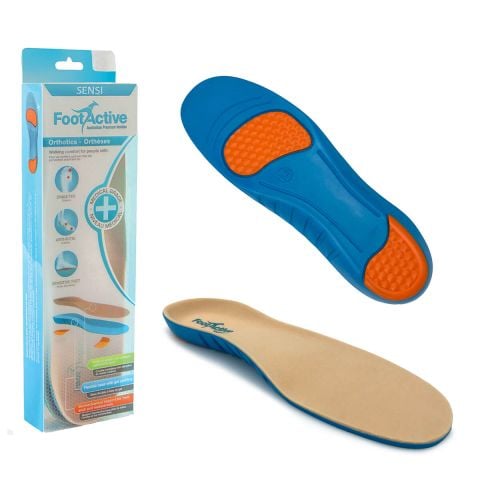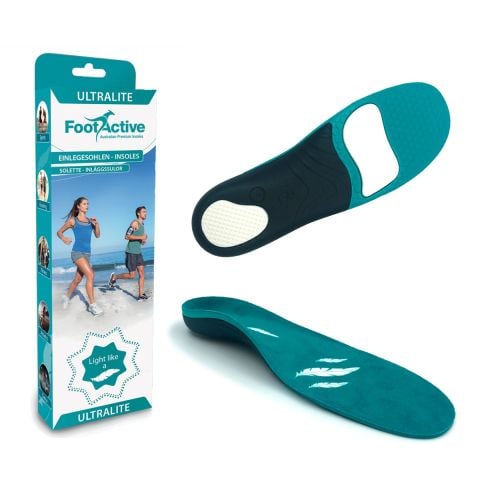Insoles for Diabetes
Diabetic foot care starts with the correct footwear. Diabetic orthotic insoles can be extremely useful when it comes to avoiding friction or pressure sores associated with diabetic foot pain. Those with over-pronation are very likely to experience these diabetic foot problems, as the fallen arches tend to allow poor foot function, with friction and pressure inside the shoe irritating particular points of the foot. Common places for this kind of friction include the ball of the foot and on the outside of the big toe, as well as on the top of the toe joints, and between the toes.
Specialist diabetic shoe inserts such as FootActive Comfort Orthotic insoles or FootActive Sensi insoles are cleverly designed to accommodate diabetic foot symptoms, offering ‘full contact’ and distributing weight over the entire surface of the foot. This not only offers support and improved comfort for the wearer, but the footbed also ensures that proper biomechanical gait is enabled, reducing, and preventing excess friction. Made from a soft-medium density EVA, the diabetic foot insoles will mould to your foot after a few weeks of wear. With the top layer crafted from soft Durapontex for extra shock absorption and comfort, diabetic wearers can get the support they need without risking friction.
NOTE: Diabetes sufferers should always consult their Physician or Podiatrist before wearing orthotics and to gain insight into the support needed.
How To Manage Diabetic Foot Problems
Diabetic foot care starts with the correct insoles for diabetes, reducing friction and improving support. However, there are a number of other actions you can take in the reduction of diabetic foot pain or discomfort, before the issues worsen. These can include the following:
- Take time to inspect your feet daily. Look out for sores, swelling discolouration, cuts, or blisters. By using a mirror, you can inspect your foot thoroughly for diabetic foot problems.
- Hygiene is key. Diabetic foot care should involve thorough cleanliness, so wash them daily with warm water and mild soap. Take the time to dry your feet carefully, paying careful attention to the spaces between the toes.
- Using lotions and foot creams on dry skin can assist with diabetic foot symptoms but avoid using these between the toes. You can utilise foot powders between the toes where needed or desired.
- Cut your toenails straight across, ensuring you keep them trimmed. Contact a chiropodist if you are unable to do this yourself.
- Change your socks and stockings every day and try to purchase seamless, fitted socks, making sure to avoid tight elastics.
If you are looking to use diabetic foot insoles or insoles for neuropathy, ensure you speak to your GP or an expert to determine whether this is the best solution for foot support. They will also be able to provide you with case-specific care instructions for your feet.
FAQs
What are the symptoms of diabetes in your feet?
If you experience swelling, pain, burning, or tingling in your feet, it could be the first sign of diabetes foot problems. However, these symptoms are quite common amongst other foot conditions too, so we would recommend seeing a GP to confirm.
Should diabetics wear socks to bed?
Sometimes it is recommended for diabetics to wear socks at night to keep feet warm and blood circulating. It also minimises the chance of causing injury.
What part of the foot hurts with diabetes?
Pain throughout the whole foot can be caused by diabetes, but often most commonly starts in the toes. It could eventually lead to lack of feeling in the feet.
How do I get rid of diabetic foot?
While you can’t completely get rid of the problem, there are measures you can take to improve every day comfort and treat foot ulcers caused by diabetes. We recommend regularly checking your feet for signs of injury (if you don’t have feeling in your feet, wounds can easily be missed), and using specialist insoles for diabetes to improve everyday comfort.
What helps diabetic wounds heal faster?
Carefully washing ulcers or wounds on your feet will help to prevent infection, and using a product such as First Honey® Mānuka Ointment will help promote faster healing to reduce the chance of causing further injury.
Can diabetics use insoles?
Arch support insoles are recommended for those with foot problems related to diabetes. FootActive Sensi insoles are the ideal choice, with a deep heel cup and soft cushioning top to reduce friction that could cause ulcers and wounds on the feet.






